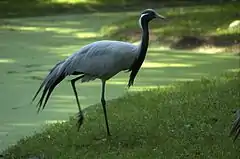| Grus[1] | |||||
| Brisson, 1760[2] | |||||
 Przedstawiciel rodzaju – żuraw stepowy (G. virgo) | |||||
| Systematyka | |||||
| Domena | |||||
|---|---|---|---|---|---|
| Królestwo | |||||
| Typ | |||||
| Podtyp | |||||
| Gromada | |||||
| Podgromada | |||||
| Infragromada | |||||
| Rząd | |||||
| Nadrodzina | |||||
| Rodzina | |||||
| Podrodzina | |||||
| Rodzaj |
Grus | ||||
| Typ nomenklatoryczny | |||||
|
Ardea grus Linnaeus, 1758 | |||||
| |||||
| Gatunki | |||||
| |||||
Zasięg występowania
Rodzaj obejmuje gatunki występujące w Ameryce Północnej, Afryce i Eurazji[12].
Morfologia
Długość ciała 90–175 cm, rozpiętość skrzydeł 150–260 cm; masa ciała 2000–12 000 g; samce są nieco większe i cięższe od samic[12].
Systematyka
Etymologia
- Scops: gr. σκοπος skopos „obserwator, strażnik”, od σκοπεω skopeō „szpiegować”[13]. Gatunek typowy: Ardea virgo Linnaeus, 1758.
- Grus: łac. grus, gruis „żuraw”[14].
- Anthropoides: gr. ανθρωπος anthrōpos „kobieta”; -οιδης -oidēs „przypominający”[15]. Gatunek typowy: Ardea virgo Linnaeus, 1758.
- Numidica: łac. Numidicus „Numidyjczyk, numidyjski”, od Numidia „Numidia”[16]. Gatunek typowy: Ardea virgo Linnaeus, 1758.
- Tetrapteryx: gr. τετρα- tetra- „cztero-”, od τεσσαρες tessares „cztery”; πτερυξ pterux, πτερυγος pterugos „skrzydło, pióra” (por. τετραπτερος tetrapteros „cztero-skrzydły”); w aluzji do wydłużonych lotek II rzędu, które rozciągają się prawie do ziemi, dając wrażenie bardzo długiego ogona[17]. Gatunek typowy: Tetrapteryx capensis Thunberg, 1818 (= Ardea paradisea A.A.H. Lichtenstein, 1793).
- Megalornis: gr. μεγας megas, μεγαλη megalē „wspaniały, znakomity”; ορνις ornis, ορνιθος ornithos „ptak”[18]. Gatunek typowy: Ardea grus Linnaeus, 1758.
- Bugeranus: gr. βου- bou- „olbrzymi, wielki”, od βους bous „wół”; γερανος geranos „żuraw”[19]. Gatunek typowy: Ardea carunculata J.F. Gmelin, 1789.
- Geranarchus: gr. γερανος geranos „żuraw”; αρχος arkhos „szef, władca”, od αρχω arkhō „rządzić”[20]. Nowa nazwa dla Anthropoides Brisson, 1760.
- Philorchemon: gr. φιλορχημων philorkhēmōn „kochający taniec”, od φιλος philos „kochający”, od φιλεω phileō „kochać”; ορχημα orkhēma „taniec”[21]. Gatunek typowy: Ardea paradisea A.A.H. Lichtenstein, 1793.
- Geranus: gr. γερανος geranos „żuraw”[22]. Nomen nudum.
- Limnogeranus: gr. λιμνη limnē „bagno”; γερανος geranos „żuraw”[23]. Gatunek typowy: Ardea americana Linnaeus, 1758.
Podział systematyczny
Do rodzaju należą następujące gatunki[24]:
- Grus carunculata (J.F. Gmelin, 1789) – żuraw koralowy
- Grus paradisea (A.A.H. Lichtenstein, 1793) – żuraw rajski
- Grus virgo (Linnaeus, 1758) – żuraw stepowy
- Grus japonensis (Statius Muller, 1776) – żuraw mandżurski
- Grus americana (Linnaeus, 1758) – żuraw krzykliwy
- Grus grus (Linnaeus, 1758) – żuraw zwyczajny
- Grus monacha Temminck, 1835 – żuraw białogłowy
- Grus nigricollis Przevalski, 1876 – żuraw czarnoszyi
Przypisy
- ↑ Grus, [w:] Integrated Taxonomic Information System (ang.).
- ↑ M.J. Brisson: Ornithologie, ou, Méthode contenant la division des oiseaux en ordres, sections, genres, especes & leurs variétés, a laquelle on a joint une description exacte de chaque espece, avec les citations des auteurs qui en ont traité, les noms quils leur ont donnés, ceux que leur ont donnés les différentes nations, & les noms vulgaires. T. 5. Parisiis: Ad Ripam Augustinorum, apud Cl. Joannem-Baptistam Bauche, bibliopolam, ad Insigne S. Genovesae, & S. Joannis in Deserto, 1760, s. 374. (fr. • łac.).
- ↑ P.H.G. Moehring: Geslachten der vogelen. Amsteldam: Pieter Meijer, 1758, s. 6, 62. (niderl.).
- ↑ L.J.P. Vieillot: Analyse d’une nouvelle ornithologie élémentaire. Paris: Deteville, libraire, rue Hautefeuille, 1817, s. 59. (fr.).
- ↑ L. von Oken. II. Klasse. Vögel. „Isis, oder, Encyclopädische Zeitung von Oken”. 1, s. 1184, 1817. (niem.).
- ↑ C.P. Thunberg. Tetrapteryx capensis, ett nytt Fogelslågte. „Kungl. Svenska vetenskapsakademiens handlingar”. For år 1818 (2), s. 242, 1818. (szw.).
- ↑ G.R. Gray: A list of the genera of birds, with their synonyma and an indication of the typical species of each genus. Wyd. 2nd ed., rev., augm., and accompanied with an index. London: Printed and sold by R. and J.E. Taylor, 1841, s. 85. (ang.).
- ↑ Gloger 1842 ↓, s. 440.
- 1 2 Gloger 1842 ↓, s. 438.
- ↑ Ch.L. Bonaparte. Notes sur les Collections rapportées en 1853, par M. A. Delattre, de son vojage en Californie et dans le Nicaragua. „Comptes rendus hebdomadaires de l’Académie des Sciences”. 38, s. 661, 1854. (fr.).
- ↑ R.B. Sharpe. The diagnoses of some apparently new genera of Cranes (Gruidæ). „Bulletin of the British Ornithologists’ Club”. 1, s. xxxvii, 1893. (ang.).
- 1 2 G.W. Archibald & C.D. Meine: Family Gruidae (Cranes). W: J. del Hoyo, A. Elliott & J. Sargatal (red.): Handbook of the Birds of the World. Cz. 3: Hoatzin to Auks. Barcelona: Lynx Edicions, 1996, s. 83–84, 88–89. ISBN 84-87334-20-2. (ang.).
- ↑ The Key to Scientific Names ↓, Scops [dostęp 2020-04-28].
- ↑ The Key to Scientific Names ↓, Grus [dostęp 2020-04-28].
- ↑ The Key to Scientific Names ↓, Anthropoides [dostęp 2020-04-28].
- ↑ The Key to Scientific Names ↓, Numidica [dostęp 2020-04-28].
- ↑ The Key to Scientific Names ↓, Tetrapteryx [dostęp 2020-04-28].
- ↑ The Key to Scientific Names ↓, Megalornis [dostęp 2020-04-28].
- ↑ The Key to Scientific Names ↓, Bugeranus [dostęp 2020-04-28].
- ↑ The Key to Scientific Names ↓, Geranarchus [dostęp 2020-04-28].
- ↑ The Key to Scientific Names ↓, Philorchemon [dostęp 2020-04-28].
- ↑ The Key to Scientific Names ↓, Geranus [dostęp 2020-04-28].
- ↑ The Key to Scientific Names ↓, Limnogeranus [dostęp 2020-04-28].
- ↑ Systematyka i nazwy polskie za: P. Mielczarek & M. Kuziemko: Podrodzina: Gruinae Vigors, 1825 - żurawie (wersja: 2017-06-25). [w:] Kompletna lista ptaków świata [on-line]. Instytut Nauk o Środowisku Uniwersytetu Jagiellońskiego. [dostęp 2020-04-02].
Bibliografia
- C.W.L. Gloger: Gemeinnütziges Hand- und Hilfsbuch der Naturgeschichte. Breslau: A. Schulz, 1842, s. 1–495. (niem.).
- The Key to Scientific Names, J.A. Jobling (red.), [w:] Birds of the World, S.M. Billerman et al. (red.), Cornell Lab of Ornithology, Ithaca (ang.).
This article is issued from Wikipedia. The text is licensed under Creative Commons - Attribution - Sharealike. Additional terms may apply for the media files.